Learning to See in Extremely Low-Light Environments with Small Data
Abstract
1. Introduction
2. Related Work
2.1. Low-Light Image Datasets
2.2. Image Denoising
2.3. Low-Light Image Restoration
3. The Approach
3.1. The End-to-End Pipeline Based on Deep Learning
3.2. Regularized Denoising Autoencoder
3.3. The Procedure of Collecting Data
4. Experiments
4.1. Dataset
4.2. Qualitative Results and Perceptual Analysis
4.3. Quantitative Analysis
4.4. Implementation Details
5. Discussion
6. Conclusions
Author Contributions
Funding
Conflicts of Interest
References
- Hu, Z.; Cho, S.; Wang, J.; Yang, M.H. Deblurring low-light images with light streaks. In Proceedings of the IEEE Conference on Computer Vision and Pattern Recognition, Columbus, OH, USA, 24–27 June 2014; pp. 3382–3389. [Google Scholar]
- Remez, T.; Litany, O.; Giryes, R.; Bronstein, A.M. Deep Convolutional Denoising of Low-Light Images. arXiv 2017, arXiv:1701.01687. [Google Scholar]
- Zhang, X.; Shen, P.; Luo, L.; Zhang, L.; Song, J. Enhancement and noise reduction of very low light level images. In Proceedings of the 21st International Conference on Pattern Recognition (ICPR2012), Tsukuba, Japan, 11–15 November 2012. [Google Scholar]
- Plotz, T.; Roth, S. Benchmarking denoising algorithms with real photographs. In Proceedings of the IEEE Conference on Computer Vision and Pattern Recognition, Honolulu, HI, USA, 21–26 July 2017; pp. 1586–1595. [Google Scholar]
- Wang, R.; Zhang, Q.; Fu, C.W.; Shen, X.; Zheng, W.S.; Jia, J. Underexposed Photo Enhancement using Deep Illumination Estimation. In Proceedings of the IEEE Conference on Computer Vision and Pattern Recognition, Long Beach, CA, USA, 16–20 June 2019. [Google Scholar]
- Hasinoff, S.W.; Sharlet, D.; Geiss, R.; Adams, A.; Barron, J.T.; Kainz, F.; Chen, J.; Levoy, M. Burst photography for high dynamic range and low-light imaging on mobile cameras. ACM Trans. Graph. 2016. [Google Scholar] [CrossRef]
- Liu, Z.; Yuan, L.; Tang, X.; Uyttendaele, M.; Suny, J. Fast burst images denoising. ACM Trans. Graph. 2014. [Google Scholar] [CrossRef]
- Mildenhall, B.; Barron, J.T.; Chen, J.; Sharlet, D.; Ng, R.; Carroll, R. Burst Denoising with Kernel Prediction Networks. In Proceedings of the IEEE Conference on Computer Vision and Pattern Recognition, Salt Lake City, UT, USA, 18–22 June 2018. [Google Scholar] [CrossRef]
- Chen, C.; Chen, Q.; Xu, J.; Koltun, V. Learning to See in the Dark. In Proceedings of the IEEE Conference on Computer Vision and Pattern Recognition, Salt Lake City, UT, USA, 18–22 June 2018. [Google Scholar] [CrossRef]
- Ronneberger, O.; Fischer, P.; Brox, T. U-Net: Convolutional Networks for Biomedical Image Segmentation. In International Conference on Medical Image Computing and Computer-Assisted Intervention; Springer: Cham, Switzerland, 2015; pp. 234–241. [Google Scholar] [CrossRef]
- Everingham, M.; van Gool, L.; Williams, C.K.I.; Winn, J.; Zisserman, A. The pascal visual object classes (VOC) challenge. Int. J. Comput. Vis. 2010. [Google Scholar] [CrossRef]
- Russakovsky, O.; Deng, J.; Su, H.; Krause, J.; Satheesh, S.; Ma, S.; Huang, Z.; Karpathy, A.; Khosla, A.; Bernstein, M.; et al. ImageNet Large Scale Visual Recognition Challenge. Int. J. Comput. Vis. 2015. [Google Scholar] [CrossRef]
- Cheng, M.M.; Zhang, Z.; Lin, W.Y.; Torr, P. BING: Binarized normed gradients for objectness estimation at 300fps. In Proceedings of the IEEE Conference on Computer Vision and Pattern Recognition, Columbus, OH, USA, 23–28 June 2014. [Google Scholar] [CrossRef]
- Lore, K.G.; Akintayo, A.; Sarkar, S. LLNet: A deep autoencoder approach to natural low-light image enhancement. Pattern Recognit. 2017. [Google Scholar] [CrossRef]
- Xu, J.; Li, H.; Liang, Z.; Zhang, D.; Zhang, L. Real-World Noisy Image Denoising: A New Benchmark. arXiv 2018, arXiv:1804.02603. [Google Scholar]
- Wei, C.; Wang, W.; Yang, W.; Liu, J. Deep Retinex Decomposition for Low-Light Enhancement. arXiv 2018, arXiv:1808.04560. [Google Scholar]
- Loh, Y.P.; Chan, C.S. Getting to know low-light images with the Exclusively Dark dataset. Comput. Vis. Image Underst. 2019. [Google Scholar] [CrossRef]
- Rudin, L.I.; Osher, S.; Fatemi, E. Nonlinear total variation based noise removal algorithms. Phys. D Nonlinear Phenom. 1992. [Google Scholar] [CrossRef]
- Mairal, J.; Bach, F.; Ponce, J.; Sapiro, G.; Zisserman, A. Non-local sparse models for image restoration. In Proceedings of the 2009 IEEE 12th International Conference on Computer Vision, Kyoto, Japan, 29 September–2 October 2009. [Google Scholar] [CrossRef]
- Dabov, K.; Foi, A.; Katkovnik, V.; Egiazarian, K. Image denoising by sparse 3-D transform-domain collaborative filtering. IEEE Trans. Image Process. 2007. [Google Scholar] [CrossRef]
- Zhang, K.; Zuo, W.; Chen, Y.; Meng, D.; Zhang, L. Beyond a Gaussian denoiser: Residual learning of deep CNN for image denoising. IEEE Trans. Image Process. 2017. [Google Scholar] [CrossRef] [PubMed]
- Xie, J.; Xu, L.; Chen, E. Image denoising and inpainting with deep neural networks. Adv. Neural Inf. Process. Syst. 2012. [Google Scholar] [CrossRef]
- Łoza, A.; Bull, D.; Achim, A. Automatic contrast enhancement of low-light images based on local statistics of wavelet coefficients. In Proceedings of the 2010 IEEE International Conference on Image Processing, Hong Kong, China, 26–29 September 2010. [Google Scholar] [CrossRef]
- Burger, H.C.; Schuler, C.J.; Harmeling, S. Image denoising: Can plain neural networks compete with BM3D? In Proceedings of the 2012 IEEE Conference on Computer Vision and Pattern Recognition, Providence, RI, USA, 16–21 June 2012. [Google Scholar] [CrossRef]
- Joshi, N.; Cohen, M.F.; Seeing, M.T. Rainier: Lucky imaging for multi-image denoising, sharpening, and haze removal. In Proceedings of the 2010 IEEE International Conference onComputational Photography (ICCP), Cambridge, MA, USA, 29–30 March 2010. [Google Scholar] [CrossRef]
- Ignatov, A.; Kobyshev, N.; Timofte, R.; Vanhoey, K.; van Gool, L. WESPE: Weakly supervised photo enhancer for digital cameras. In Proceedings of the IEEE Conference on Computer Vision and Pattern Recognition Workshops, Salt Lake City, UT, USA, 18–22 June 2018. [Google Scholar] [CrossRef]
- Dong, X.; Wang, G.; Pang, Y.; Li, W.; Wen, J.; Meng, W.; Lu, Y. Fast efficient algorithm for enhancement of low lighting video. In Proceedings of the 2011 IEEE International Conference on Multimedia and Expo, Barcelona, Spain, 18–15 July 2011. [Google Scholar] [CrossRef]
- Guo, X.; Li, Y.; Ling, H. LIME: Low-light image enhancement via illumination map estimation. IEEE Trans. Image Process. 2017. [Google Scholar] [CrossRef] [PubMed]
- LeCun, Y.; Boser, B.; Denker, J.S.; Henderson, D.; Howard, R.E.; Hubbard, W.; Jackel, L.D. Backpropagation Applied to Handwritten Zip Code Recognition. Neural Comput. 1989, 1, 541–551. [Google Scholar] [CrossRef]
- le Cun, Y.; Fogelman-Soulié, F. Modèles connexionnistes de l’apprentissage, Intellectica. Rev. l’Association Pour Rech. Cogn. 1987. [Google Scholar] [CrossRef]
- Hinton, G.E.; Zemel, R.S. Autoencoders Minimum Description Length and Helmholtz free Energy. Adv. Neural Inf. Process. Syst. 1994. [Google Scholar] [CrossRef]
- Poggio, T.; Torre, V.; Koch, C. Computational vision and regularization theory. Nature 1985. [Google Scholar] [CrossRef]
- Friedman, J.H. Regularized discriminant analysis. J. Am. Stat. Assoc. 1989. [Google Scholar] [CrossRef]
- Vincent, P.; Larochelle, H.; Bengio, Y.; Manzagol, P.A. Extracting and composing robust features with denoising autoencoders. In Proceedings of the 25th International Conference on Machine Learning, Helsinki, Finland, 5–9 July 2008. [Google Scholar] [CrossRef]
- Goodfellow, A.C.I. Yoshua Bengio, Deep Learning Book. Deep Learn. 2015. [Google Scholar] [CrossRef]
- Li, M.; Liu, J.; Yang, W.; Sun, X.; Guo, Z. Structure-Revealing Low-Light Image Enhancement Via Robust Retinex Model. IEEE Trans. Image Process. 2018. [Google Scholar] [CrossRef]
- Ren, X.; Li, M.; Cheng, W.H.; Liu, J. Joint enhancement and denoising method via sequential decomposition. In Proceedings of the 2018 IEEE International Symposium on Circuits and Systems (ISCAS), Florence, Italy, 27–30 May 2018; pp. 1–5. [Google Scholar]
- Wang, Z.; Bovik, A.C.; Sheikh, H.R.; Simoncelli, E.P. Image quality assessment: From error visibility to structural similarity. IEEE Trans. Image Process. 2004. [Google Scholar] [CrossRef] [PubMed]
- Chen, X.; Zhang, Q.; Lin, M.; Yang, G.; He, C. No-reference color image quality assessment: From entropy to perceptual quality, Eurasip. J. Image Video Process. 2019. [Google Scholar] [CrossRef]
- Zhang, L.; Zhang, L.; Bovik, A.C. A feature-enriched completely blind image quality evaluator. IEEE Trans. Image Process. 2015. [Google Scholar] [CrossRef] [PubMed]
- Mittal, A.; Soundararajan, R.; Bovik, A.C. Making a “completely blind” image quality analyzer. IEEE Signal Process. Lett. 2013. [Google Scholar] [CrossRef]
- Liu, L.; Liu, B.; Huang, H.; Bovik, A.C. No-reference image quality assessment based on spatial and spectral entropies. Signal Process. Image Commun. 2014. [Google Scholar] [CrossRef]
- He, K.; Zhang, X.; Ren, S.; Sun, J. Deep Residual Learning for Image Recognition. In Proceedings of the 2016 IEEE Conference on Computer Vision and Pattern Recognition, Las Vegas, NV, USA, 27–30 June 2016. [Google Scholar] [CrossRef]
- Xu, Y.; Wang, H.; Liu, X. An improved multi-branch residual network based on random multiplier and adaptive cosine learning rate method. J. Vis. Commun. Image Represent. 2019, 59, 363–370. [Google Scholar] [CrossRef]
- Kingma, D.P.; Ba, J.L. Adam: A method for stochastic optimization. arXiv 2015, arXiv:1412.6980. [Google Scholar]
- Xu, B.; Wang, N.; Chen, T.; Li, M. Empirical Evaluation of Rectified Activations in Convolutional Network. arXiv 2015, arXiv:1505.00853. [Google Scholar]
- Salakhutdinov, R.; Mnih, A.; Hinton, G. Restricted Boltzmann machines for collaborative filtering. In Proceedings of the 24th International Conference on Machine Learning, Corvalis, OR, USA, 20 June 2007; pp. 791–798. [Google Scholar]
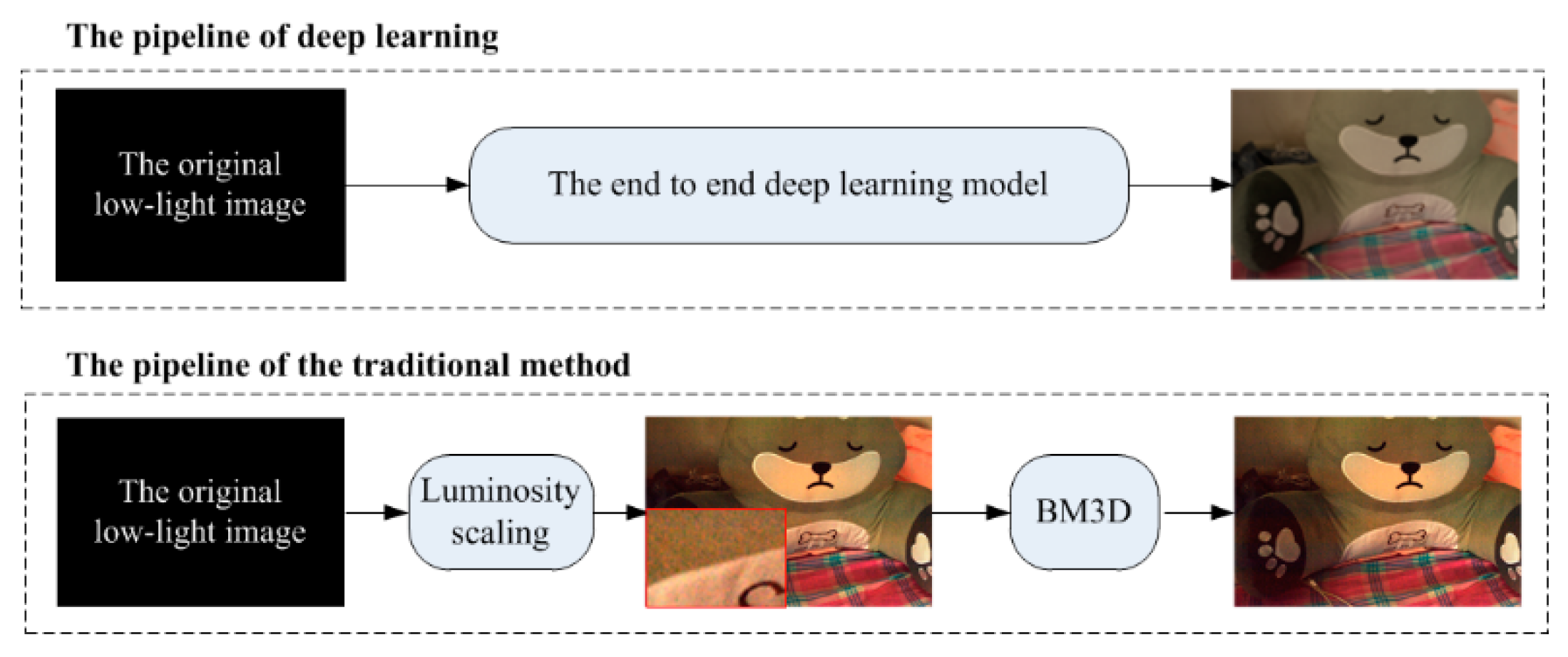
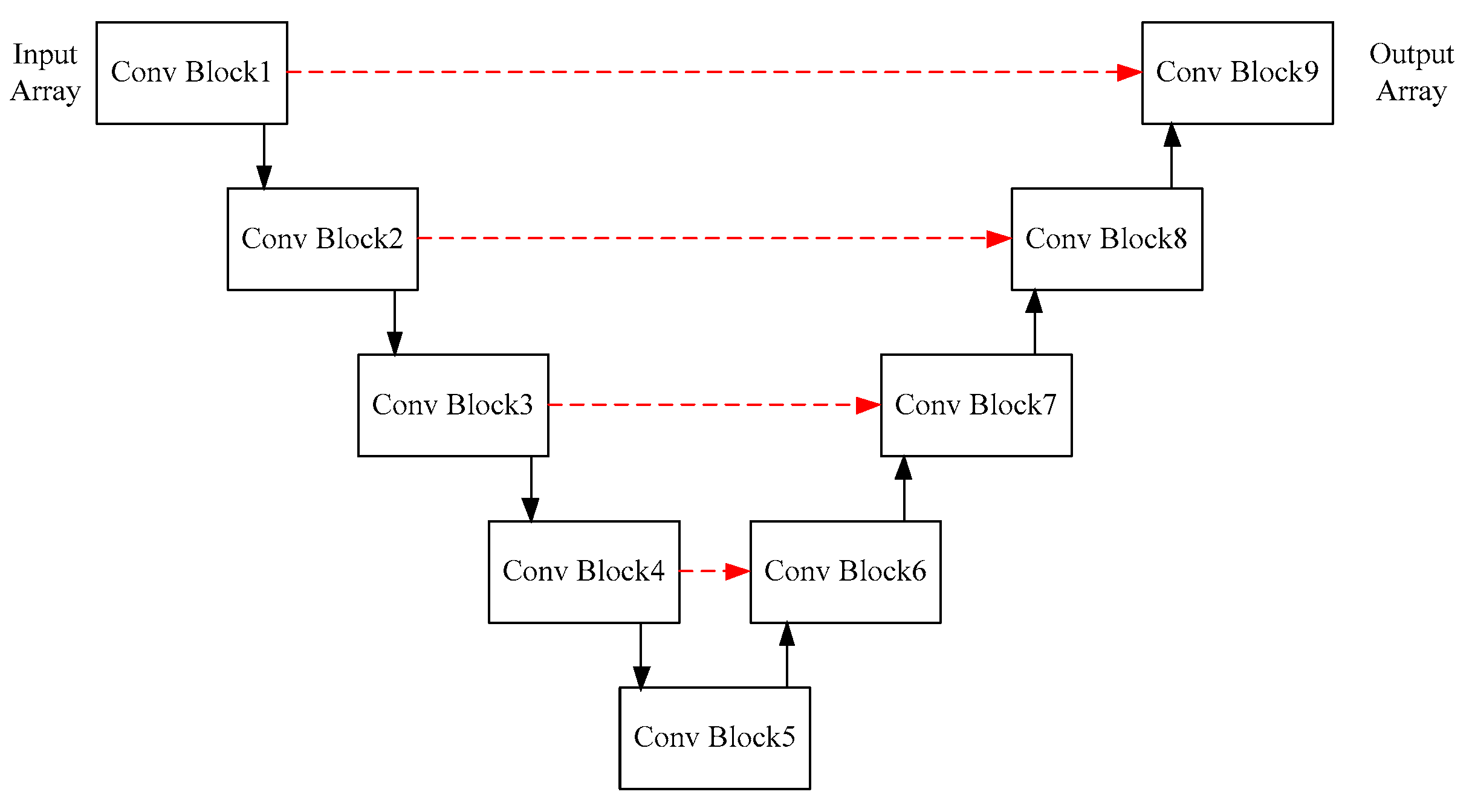
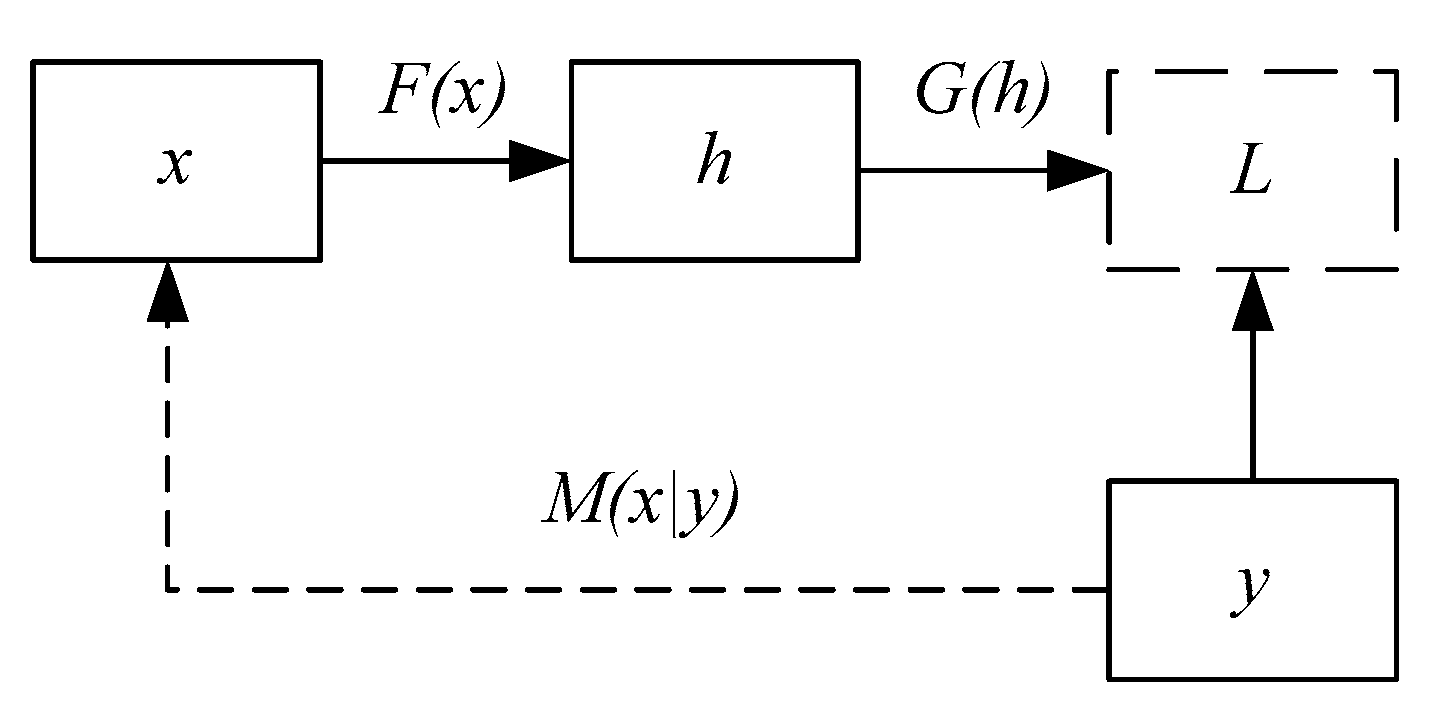
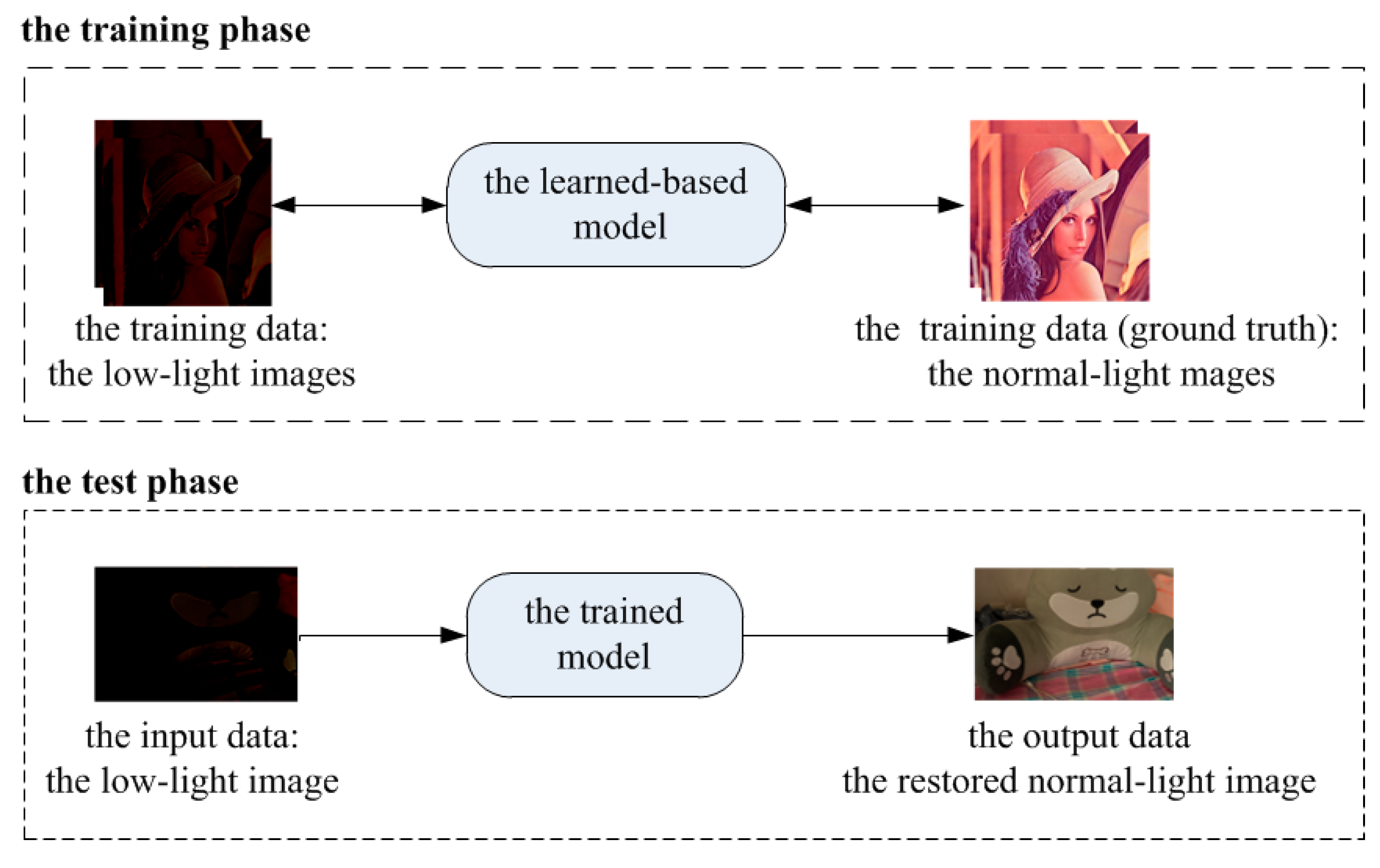

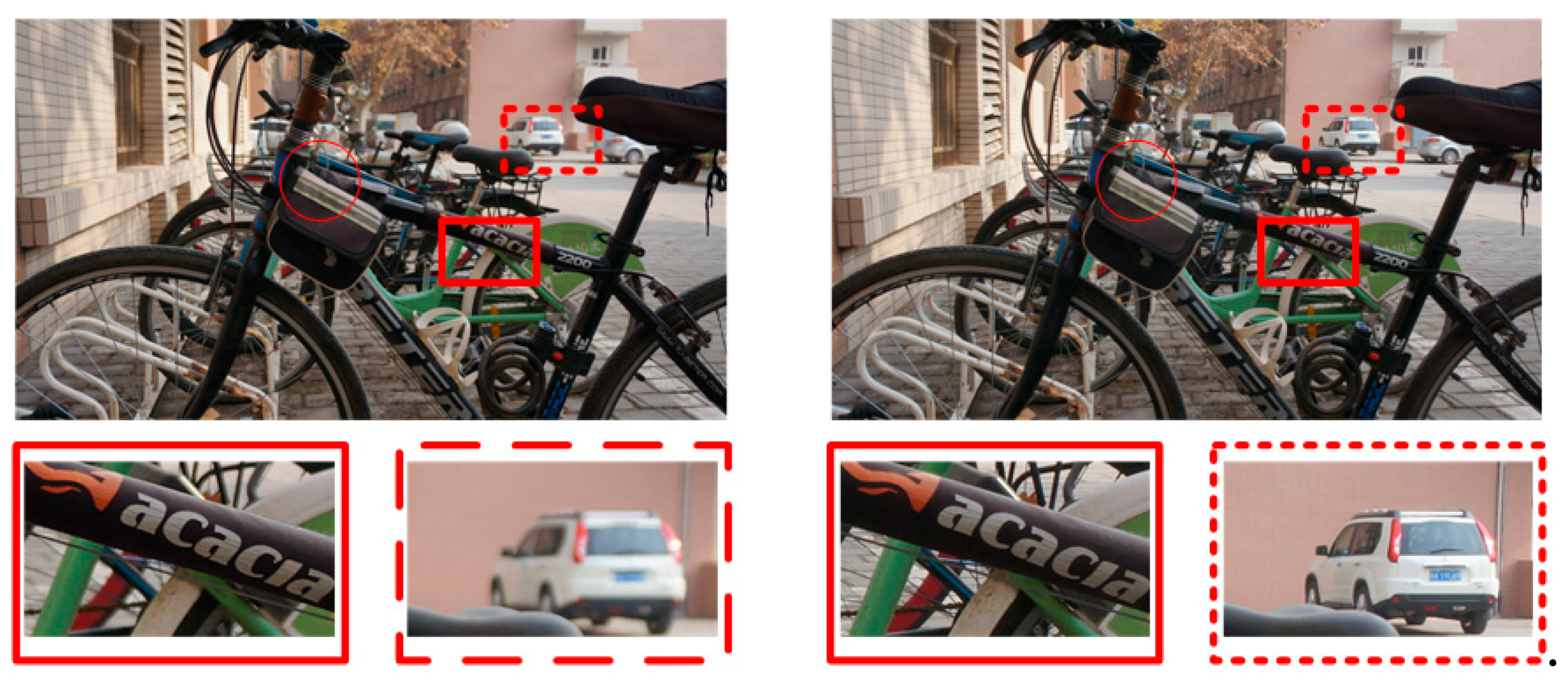

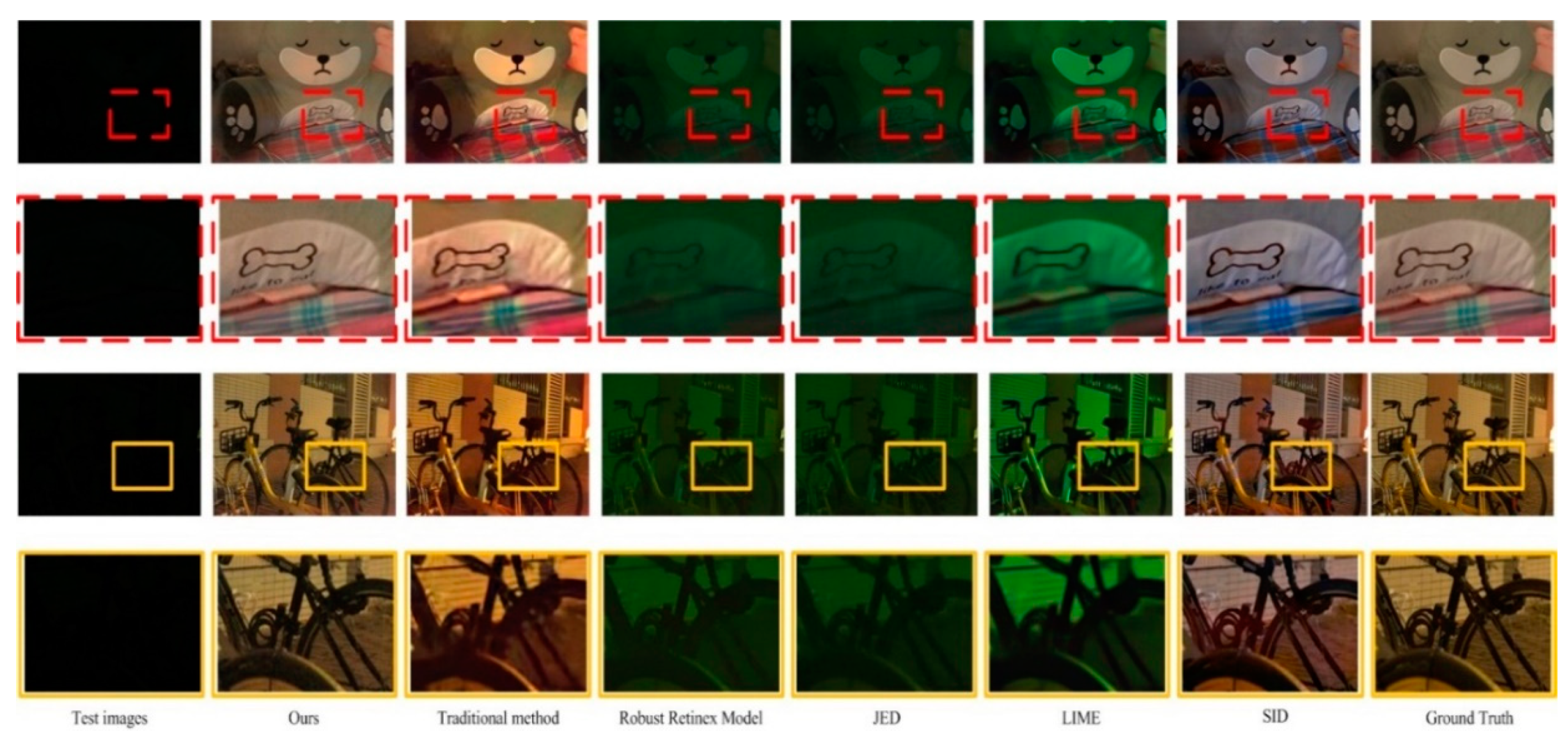

| ID of the Block | The First Layer | The Second Layer | The Third Layer |
|---|---|---|---|
| Block 1 | Conv2d(32, [3,3]) | Conv2d(32, [3,3]) | Max pooling2d |
| Block 2 | Conv2d(64, [3,3]) | Conv2d(64, [3,3]) | Max pooling2d |
| Block 3 | Conv2d(128, [3,3]) | Conv2d(128, [3,3]) | Max pooling2d |
| Block 4 | Conv2d(256, [3,3]) | Conv2d(256, [3,3]) | Max pooling2d |
| Block 5 | Conv2d(512, [3,3]) | Conv2d(512, [3,3]) | none |
| Block 6 | Conv2d(256, [3,3]) | Conv2d(256, [3,3]) | none |
| Block 7 | Conv2d(128, [3,3]) | Conv2d(128, [3,3]) | none |
| Block 8 | Conv2d(64, [3,3]) | Conv2d(64, [3,3]) | none |
| Block 9 | Conv2d(32, [3,3]) | Conv2d(32, [3,3]) | Conv2d(12, [1,1]) |
| ID | EXIF | ID | EXIF | ID | EXIF | ID | EXIF |
|---|---|---|---|---|---|---|---|
| 1 | GT: F16.0, 1/8 s, ISO 100 Dark: 1/800 s | 2 | GT: F16.0, 1 s, ISO 100 Dark: 1/100 s | 3 | GT: F16.0, 1/4 s, ISO 100 Dark: 1/400 s | 4 | GT: F16.0, 1/8 s, ISO 100 Dark: 1/800 s |
| 5 | GT: F16.0, 1/10 s, ISO 100, +1.0 EV Dark: 1/1000 s | 6 | GT: F16.0, 1/10 s, ISO 100, +1.0 EV Dark: 1/1000 s | 7 | GT: F16.0, 1/10 s, ISO 100, +1.0 EV Dark: 1/1000 s | 8 | GT: F16.0, 1/8 s, ISO 100, +1.0 EV Dark: 1/800 s |
| 9 | GT: F16.0, 1/4 s, ISO 100, +1.0 EV Dark: 1/400 s | 10 | GT: F16.0, 1/4 s, ISO 100, +1.0 EV Dark: 1/400 s | 11 | GT: F16.0, 1/4 s, ISO 100, +1.0 EV Dark: 1/400 s | 12 | GT: F16.0, 1/2 s, ISO 100, +1.0 EV Dark: 1/200 s |
| 13 | GT: F16.0, 1/5 s, ISO 100, +1.0 EV Dark: 1/500 s | 14 | GT: F16.0, 1/8 s, ISO 100, +1.0 EV Dark: 1/800 s | 15 | GT: F16.0, 1/8 s, ISO 100, +1.0 EV Dark: 1/800 s | 16 | GT: F16.0, 3 s, ISO 100, +1.0 EV Dark: 1/30 s |
| 17 | GT: F16.0, 3 s, ISO 100, +1.0 EV Dark: 1/30 s | 18 | GT: F16.0, 2 s, ISO 100, +1.0 EV Dark: 1/50 s | 19 | GT: F16.0, 1/4 s, ISO 100, +1.0 EV Dark: 1/400 s | 20 | GT: F16.0, 1/4 s, ISO 100, +1.0 EV Dark: 1/400 s |
| Class of Methods | The Training Data | The Test Data |
|---|---|---|
| Traditional methods [20] | None | Low-light environment |
| Methods based on deep learning [5,9,14] | Low-light environment | Low-light environment |
| Our methods | Normal-light environment | Low-light environment |
| Assessment Methods | Our Method | The Traditional Method | Robust Retinex Model | JED | LIME | SID | Ground Truth |
|---|---|---|---|---|---|---|---|
| PSNR | 27.4600 (2) | 22.1908 | 12.5453 | 12.3313 | 14.3542 | 21.7659 | Inf (1) |
| SSIM [38] | 0.9479 (2) | 0.8593 | 0.3019 | 0.2726 | 0.3442 | 0.5128 | 1 (1) |
| ENIQA [39] | 0.0762 (2) | 0.2004 | 0.5808 | 0.5499 | 0.3101 | 0.1900 | 0.0709 (1) |
| IL-NIQE [40] | 34.3996 (3) | 37.4977 | 71.1242 | 75.1293 | 70.9793 | 34.3299 (2) | 30.9900 (1) |
| NIQE [41] | 4.6251 (1) | 5.5973 | 8.5458 | 7.6560 | 7.9087 | 5.1727 | 4.7387 (2) |
| SSEQ [42] | 5.3654 (1) | 29.0665 | 37.1942 | 19.3989 | 35.3465 | 30.2516 | 15.8142 (2) |
| Assessment Methods | Our Method | The Traditional Method | Robust Retinex Model | JED | LIME | SID | Ground Truth |
|---|---|---|---|---|---|---|---|
| PSNR | 30.8136 (2) | 21.1950 | 11.9917 | 11.9579 | 13.7948 | 23,4298 | Inf (1) |
| SSIM [38] | 0.9535 (2) | 0.8106 | 0.1963 | 0.1832 | 0.2072 | 0.8374 | 1 (1) |
| ENIQA [39] | 0.1320 (2) | 0.2860 | 0.1476 | 0.2346 | 0.2048 | 0.1658 | 0.0995 (1) |
| IL-NIQE [40] | 25.1430(3) | 25.5302 | 50.0900 | 47.2871 | 46.7496 | 23.6752 (1) | 24.7926 (2) |
| NIQE [41] | 3.6368 (1) | 4.1941 | 7.0819 | 5.7749 | 7.0317 | 3.7191 (2) | 3.7534 |
| SSEQ [42] | 15.6676(1) | 38.2989 | 35.0894 | 28.4950 | 42.2645 | 24.2338 | 19.7217 (2) |
| Assessment Methods (Restoration Algorithm) | 50× | 100× | 200× | 400× | 750× |
|---|---|---|---|---|---|
| ENIQA [39] (Ours) | 0.0694 | 0.0701 | 0.0800 | 0.1369 | 0.1856 |
| ENIQA (TM) | 0.2583 | 0.2318 | 0.2793 | 0.4141 | 0.5599 |
| IL-NIQE [40] (Ours) | 36.5769 | 38.7293 | 47.2164 | 58.6588 | 71.5074 |
| IL-NIQE (TM) | 50.1786 | 50.9244 | 62.1660 | 80.4942 | 96.9210 |
| NIQE [41] (Ours) | 6.1894 | 5.9605 | 6.0204 | 6.7881 | 7.0984 |
| NIQE (TM) | 7.5423 | 7.5152 | 8.4179 | 8.6997 | 9.1467 |
| SSEQ [42] (Ours) | 2.4008 | 4.0506 | 4.6036 | 9.4805 | 13.3380 |
| SSEQ (TM) | 21.6355 | 22.9971 | 19.5719 | 17.6767 | 15.8840 |
© 2020 by the authors. Licensee MDPI, Basel, Switzerland. This article is an open access article distributed under the terms and conditions of the Creative Commons Attribution (CC BY) license (http://creativecommons.org/licenses/by/4.0/).
Share and Cite
Xu, Y.; Wang, H.; Cooper, G.D.; Rong, S.; Sun, W. Learning to See in Extremely Low-Light Environments with Small Data. Electronics 2020, 9, 1011. https://doi.org/10.3390/electronics9061011
Xu Y, Wang H, Cooper GD, Rong S, Sun W. Learning to See in Extremely Low-Light Environments with Small Data. Electronics. 2020; 9(6):1011. https://doi.org/10.3390/electronics9061011
Chicago/Turabian StyleXu, Yifeng, Huigang Wang, Garth Douglas Cooper, Shaowei Rong, and Weitao Sun. 2020. "Learning to See in Extremely Low-Light Environments with Small Data" Electronics 9, no. 6: 1011. https://doi.org/10.3390/electronics9061011
APA StyleXu, Y., Wang, H., Cooper, G. D., Rong, S., & Sun, W. (2020). Learning to See in Extremely Low-Light Environments with Small Data. Electronics, 9(6), 1011. https://doi.org/10.3390/electronics9061011





